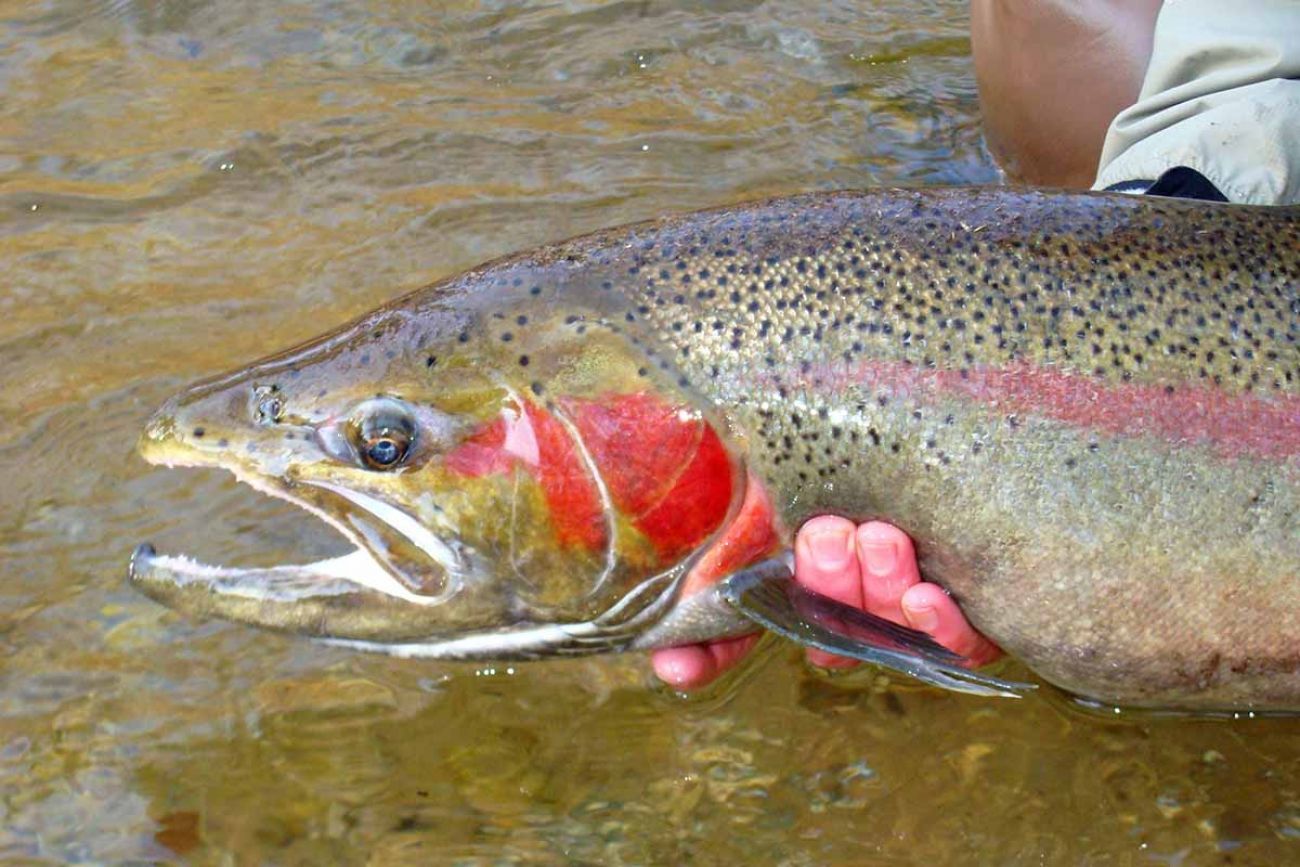Concerns about Michigan steelhead populations prompt new catch limits

- Anglers in some Michigan rivers will be limited to keeping one steelhead daily, down from the previous limit of three
- The changes come amid fears that Michigan’s steelhead population is struggling
- State scientists opposed the change, arguing steelhead populations are stable
Anglers will be allowed to keep fewer steelhead trout in a handful of Michigan rivers, after state regulators tightened regulations over fears of population declines.
The Michigan Natural Resources Commission unanimously approved the change Thursday, after lengthy testimony from anglers who are divided on the issue. The changes will take effect April 1.
Under the new regulations, anglers on certain sections of the Carp, Betsie, Manistee, Little Manistee, Muskegon, Rogue, Pere Marquette, Whitefish and White rivers, along with sections of Bear and Prairie creeks, will be allowed to keep just one steelhead a day. That’s down from a previous limit of three-per-day in most cases.
Related:
- Steelhead bag limits reduced in some Michigan waters amid fish declines
- Invasive mussels now control key Great Lakes nutrients, threatening fish
- Michigan steps up dam removal in race against climate change
The limits come after years of debate within the angling community and state government over whether steelhead populations are struggling and, if so, what to do about it.
“I think we need to take these steps now, in order to protect the situation while we find out what the answers are,” Commission Chair Tom Baird said before Thursday’s vote.
Scientists with the Michigan Department of Natural Resources opposed making changes, arguing that steelhead populations are stable and population growth is hindered not by anglers, but by environmental factors such as the invasive mussel takeover of the Great Lakes.
“These fish spend most of their life in the lakes,” said Jay Wesley, the Lake Michigan Basin Coordinator for the DNR’s Fisheries Division, “so the condition of the lake is what determines how many we have and how big they get.”
The debate goes back years. Natural resources commissioners began considering changes after hearing concerns from some anglers, particularly fishing guides who say Michigan’s reputation as a steelhead fishing destination is slipping because the fish are in decline. At one point, commissioners considered imposing a statewide one-a-day limit.
Steelhead are migratory rainbow trout native to the West Coast. The fish established wild populations in some Michigan watersheds after humans imported them decades ago. The state continues to stock some rivers with steelhead raised in hatcheries.
Born in rivers, steelhead spend most of their lives in the Great Lakes before returning inland to spawn. Averaging nine pounds and topping out at about 20, they’re much larger than river-dwelling trout. They’re a popular sportfish known for putting up a fight when hooked and putting a lot of food on the table, making Michigan’s fall and spring steelhead runs highly-anticipated fishing events.
Once abundant in lakes Michigan and Huron, their numbers dwindled in the early 2000s, when invasive mussels transformed the lakes’ ecosystems. Mussels coat the lake bottoms in every Great Lake except Superior, filtering plankton and algae out of the water and robbing the lakes of nutrients that fish need to survive.
There are now an estimated two million steelhead in Lake Michigan. That figure has remained consistent in recent years, leading state scientists to conclude the population is stable.
But some anglers say they’re noticing changes, from smaller fish to fewer bites on their lines. Growing threats from invasive species and climate change only add to the concern.
“The last five to seven years has been a continuing decline,” said Ray Schmidt, a retired Manistee County fishing guide who said he has kept 20 years of stats.
Gaps in state data on steelhead populations helped fuel the debate, with anglers on both sides lamenting that Michigan doesn’t spend more time and money tracking steelhead populations.
“We all need better data to make more confident decisions,” said Bryan Burroughs, executive director of Michigan Trout Unlimited, which supports the catch limits. But he added: “We do see that there is reason to be concerned for steelhead.”
Opponents joined DNR staff in arguing that further restricting catch-and-keep fishing won’t make a difference in the species’ long-term survival.
“Overharvest of wild fish is not the problem,” said Dennis Eade, executive director of the Michigan Steelhead and Salmon Fishermen’s Association. “The problem is the cycle that we’re in.”
The state has repeatedly reduced steelhead catch limits since the 1990s in response to population declines.
In most of Michigan, the steelhead bag limit is three fish per day. But in 2021, the state reduced allowable catch in a handful of rivers to one daily during the spring spawning season. Thursday’s year-round restriction in several rivers adds yet another change.
Wesley, of the DNR, said adult steelhead are “saturating” available spawning habitat, leading him to doubt that restricting fishing will boost reproduction.
If Michigan wants more steelhead, he said, it must either improve conditions in the Great Lakes — something that will be difficult with mussels dominating the ecosystem — or open up more spawning habitat in rivers by removing dams or improving habitat.
But as Bridge Michigan has reported, a DNR push to remove dams is hindered by a lack of funding and social pressure to maintain reservoirs that have become valued recreational lakes.
See what new members are saying about why they donated to Bridge Michigan:
- “In order for this information to be accurate and unbiased it must be underwritten by its readers, not by special interests.” - Larry S.
- “Not many other media sources report on the topics Bridge does.” - Susan B.
- “Your journalism is outstanding and rare these days.” - Mark S.
If you want to ensure the future of nonpartisan, nonprofit Michigan journalism, please become a member today. You, too, will be asked why you donated and maybe we'll feature your quote next time!




